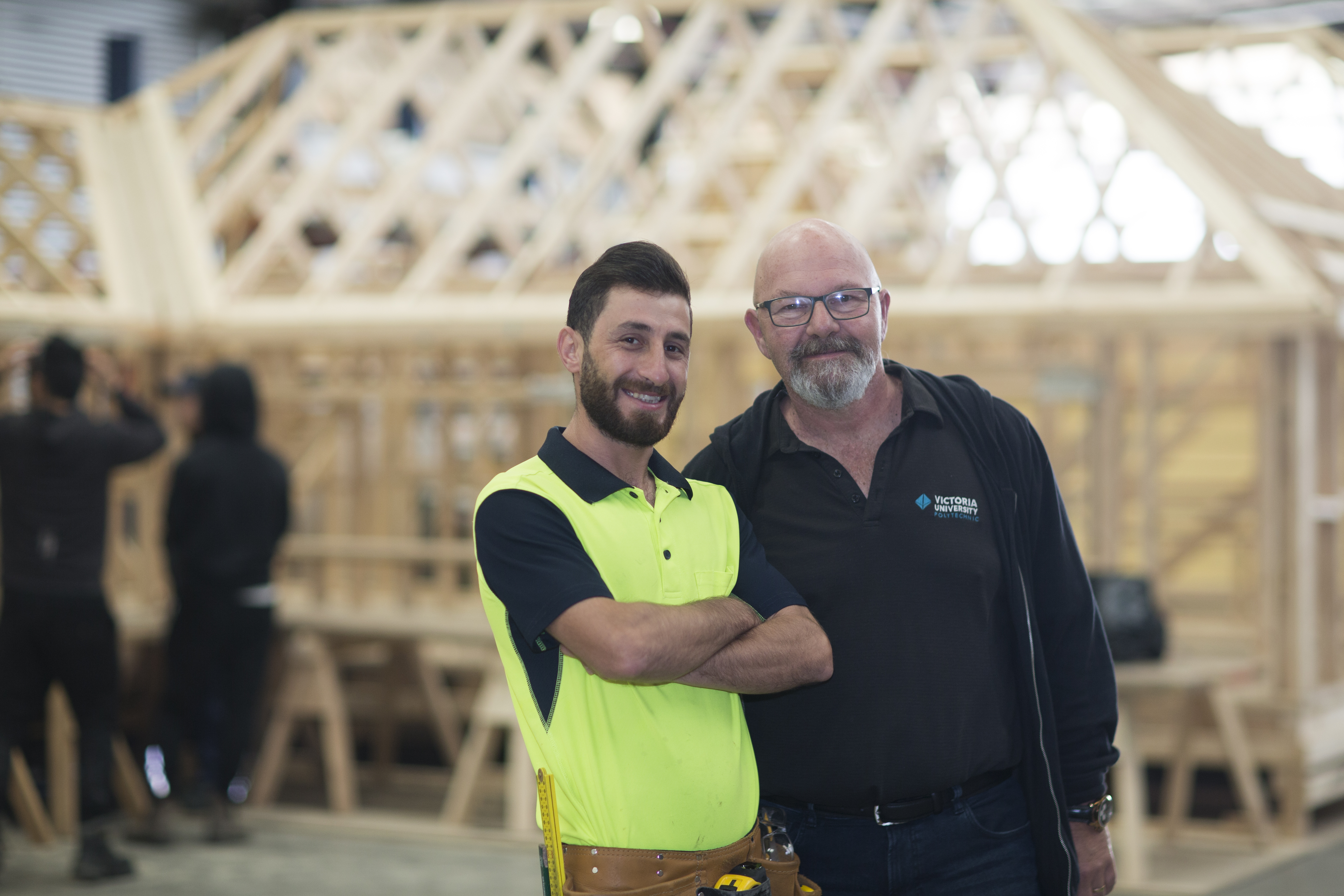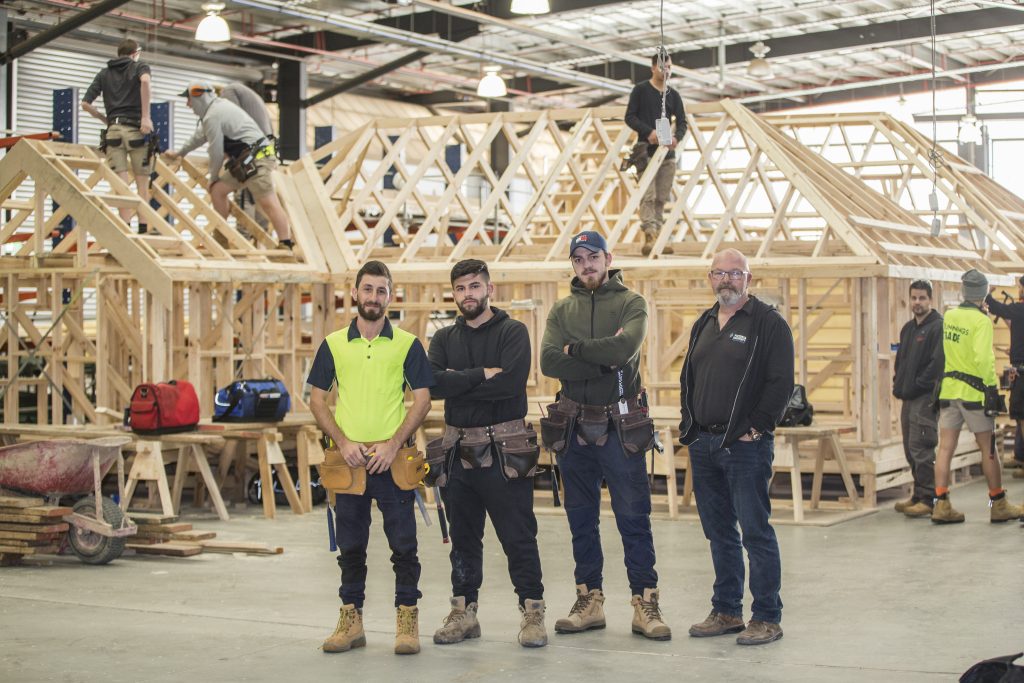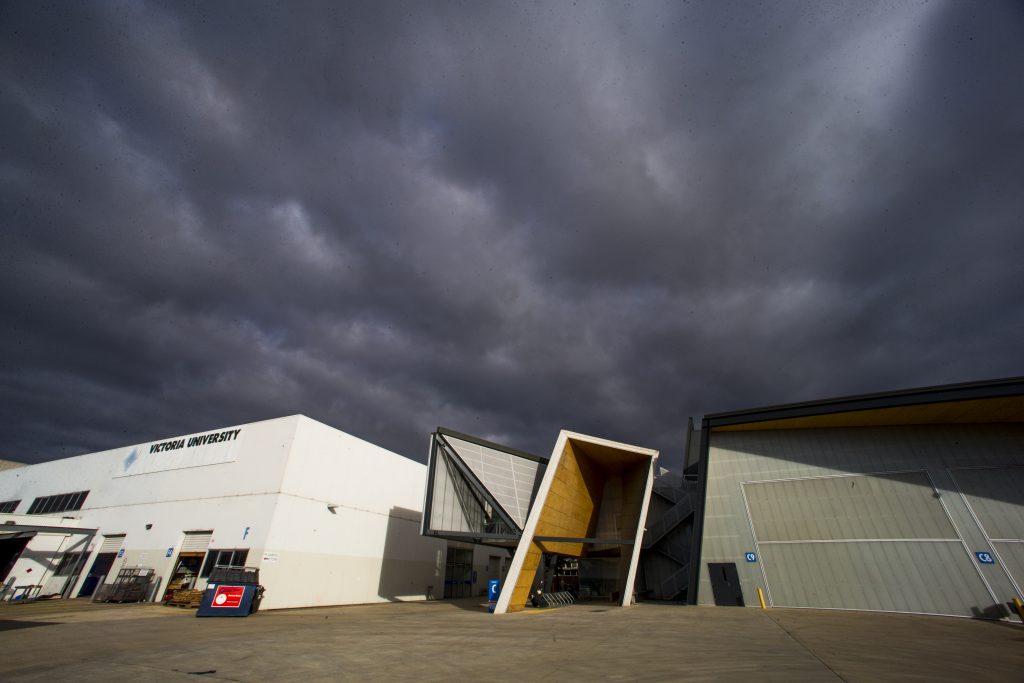
TAFE & Adult Provision All Sunshine: building social cohesion at TAFE

A program at Victoria Polytechnic – aka Sunshine TAFE – in Melbourne’s inner-west is building social cohesion.
Victoria Polytechnic has found its way into some of the most beloved Australian small screen stories. This is where the Kerrigans’ daughter, Tracey, obtained her hairdressing qualification in 1997 film The Castle. Fast-forward a decade and Kath Day-Knight from Kath & Kim was boasting about the numerous qualifications she gained at Sunshine TAFE. Right now, though, walking the campus in Melbourne’s inner-west, you’d be more likely to encounter Burmese or Sudanese students than a blonde, frizzy-fringed Tracey or a poodle-permed Kath.
“It’s the United Nations here!” chuckles Norm Colling, a carpentry teacher who runs the Certificate II Pre-Apprenticeship program. He’s seen huge change in the demographics of his student cohort over the past 17 years on the job.
“When I started out we had a lot of Vietnamese, they began settling in the Sunshine area from the 1970s onwards,” he recalls. “Then around 10 years ago we started to see a lot of Burmese Karen refugees, and more recently Iraqi, Indian and Sudanese.”
For Norm, one of the sweetest parts of his job is going out on sites to visit apprentices – especially the ones who have been hired by his own former students. “The real success stories have been in the last seven or eight years. A lot of our students have come from refugee camps on the Thai-Burma border. They’ve done their pre-apprenticeship training in carpentry and bricklaying with us, and then they become employers themselves, and contact us asking for apprentices. It’s the same with our Vietnamese students, too. It’s fantastic. The whole system’s working really well.”
Norm has also noticed a broader attitudinal change amongst Anglo-Australian employers. “When I first started 17 years back, there was a perception that the Aussie employer had to employ another Aussie. But then they found that [these new arrivals] are extremely hard-working and reliable. That’s all you want: someone who’ll turn up every day and work hard. Word travels around.”
“Creating a positive, high-functioning learning environment doesn’t just happen. You need to actively create that culture of inclusivity.”
A bike ride through Melbourne’s west will see you pass by bustling African hairdressers, cherry and apple smoke hanging in the air from the hookah cafes, shiny red Peking ducks hanging from restaurant windows. Post-World War II continental migrants run market stalls selling hummus, flatbread and marinated feta next to migrants and refugees from across Asia and Africa. Head further west, and on one side of the road, you will pass Gilmore College girls in hijabs chatting together at the bus stop, sipping lattes. While across the street there’s a hipster t-shirt shop, a pizza joint, and a mystifying Vietnamese office with signs advertising both orchids and tax return assistance.
According to a recent census, the most common ancestry in Sunshine was Vietnamese at 12.9%, with Australian at 11.4% and English at 12.5%. For country of birth, less than half the population was born in Australia, while the other most common countries of birth were Vietnam, India, Burma, Philippines and Nepal. The west, particularly the Wyndham area, is the third largest growth area in Australia, so it’s unsurprising that Norm’s construction pre-apprenticeship program is brimming with enrolments.

“There’s plenty of building work out there,” says Norm, “That, combined with the fact that Dan Andrews made TAFE free, has meant our student numbers have increased big-time. It’s provided real access to people who may not have been able to afford to go to TAFE a few years back.”
So how does this extraordinary level of cultural diversity play out at TAFE? And how does Norm achieve such consistent success with his pre-apprentice students when so many of them struggle with language and cultural barriers?
“Creating a positive, high-functioning learning environment doesn’t just happen,” he says. “You need to actively create that culture of inclusivity.”
For Norm, that begins with laying down the ground rules and getting the students collaborating closely early on. “For a start, we won’t tolerate racism. It’s not accepted in the workplace and it’s not accepted here. And then, right from the get-go, a lot of the jobs we do, we do it as a team. It sets up that teamwork culture, where everyone’s accepted based on what they bring to the table. You just don’t see any racism, it just doesn’t come into it.”
“It’s a TAFE approach I think: to take people as they come.”
The strong culture of egalitarianism and mutual respect is central to TAFE’s ethos – Norm is quick to mention he treats the students like adults and everyone relates on a first-name basis – but there’s something deeper at play. He says that he’s also come to understand the importance of flexibility, acceptance and empathy.
“I was fortunate in my childhood; I didn’t have a broken home and my parents weren’t drunk or anything like that, and I tended to mix in that same ilk I’d grown up with. Since being here, I’ve really learnt to have compassion for people and their circumstances and not judge them, especially because a lot of our students are only 16 to 18 years old; a lot of their circumstance isn’t their fault. I try to accommodate them and understand where they’re coming from. It’s a TAFE approach I think: to take people as they come.”
He gives the example of having a student who would routinely arrive late because, as it turned out, he had to drop a little sister off at school. “That’s something we want to accommodate, not punish – because, at the end of the day, the most important thing is that he’s made the decision to come to TAFE, so let’s make that work.”
For students with additional literacy and numeracy needs, the TAFE system kicks in early on with the offer of intensive support. “When a student starts, they sit a basic test and that just helps us flag where they sit. We have maths and English teachers who will take them one-on-one for one or two hours a week to get their literacy and numeracy up.”
Students who are struggling can access up to 30 hours of individual tuition throughout their 15-week pre-apprenticeship course.
“The tutors teach them carpentry maths, or bricklaying maths. They don’t teach them things that they’ll never use in the workplace. We’ve designed a program where we hope that every student who comes in here will be successful.”
“To learn, and achieve, you need to be able to take risks, but you can’t do that if you don’t believe in yourself. So, if you can lift the students’ confidence, you’re half way there.”
Norm is also quick to add that disadvantage isn’t solely experienced by students from diverse cultural and linguistic backgrounds. “It doesn’t matter what culture they’ve come from, we have students that have been kicked from pillar to post all their lives.”
The key, says Norm, is boosting their self-esteem and building their confidence through doing.
“To learn, and achieve, you need to be able to take risks, but you can’t do that if you don’t believe in yourself. So, if you can lift the students’ confidence, you’re half way there. In the past they may have been told by teachers that they’re stupid. We want to change that story and play to their strengths.”
In some cases that can be as simple as teaching to their preferred learning styles – and embracing, rather than fighting, their affinity with technology.
“When we take the students from the workshop into the classroom, it’s horrible! They don’t like it, but we obviously still need to teach them theory. So if we can sit out on saw stools and go through the theory outside, they’re much happier.
“I also find that when they’re not doing that hands-on work, half of them will pull out their mobiles and then you’ve lost them. So I’ve had to change the way I teach. I show the kids carpentry apps like Quickchippy and Quickdecks, apps to help with pitching rooves or building a staircase.”

A tour around the monolithic building and construction workshop reveals separate areas for bricklaying, furniture studies, hand tools, power tools, door-hanging… and then there’s the house.
“Yep, we do full-sized projects here, they made that themselves!” says Norm. The walls are slightly lower than the 2.4m usual height – “You need a full scaffold for anything over the two-metre mark” – but, aside from that, it’s a proper house.
“They do all the stumps, bearers, joists, lay a floor, pitch a conventional roof, put the windows in, weatherboard the outside of it… and then their last week here, they do demolition and pull it all down,” he chuckles. “If we kept them all, we’d need 50 sheds!”
For Norm, completing the building is one of the best points in the 15-week course. “You know you’ve done something right when they all want photos of themselves sitting up together on the top plate so they can show their mates or their mum what they’ve done.
“For a lot of these kids, they may have never been proud of something they’ve done at school before, so it’s a big moment. We hope that helps set them up for life.”



